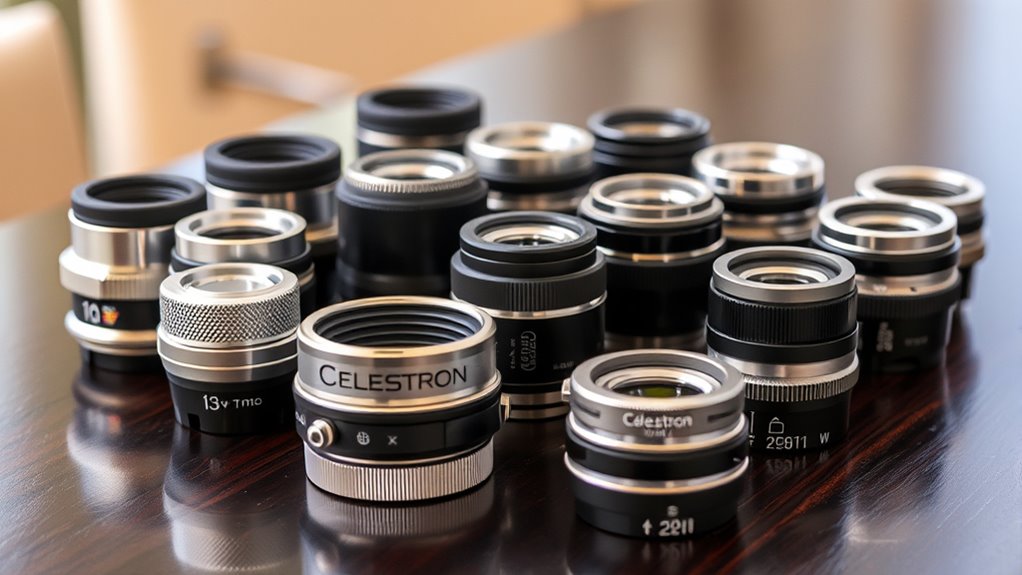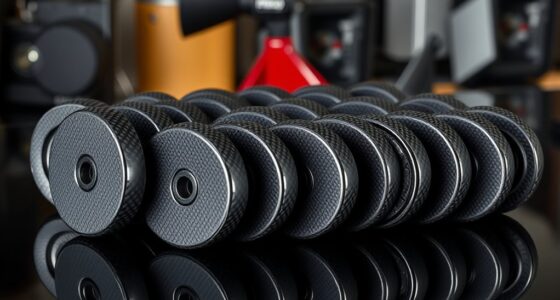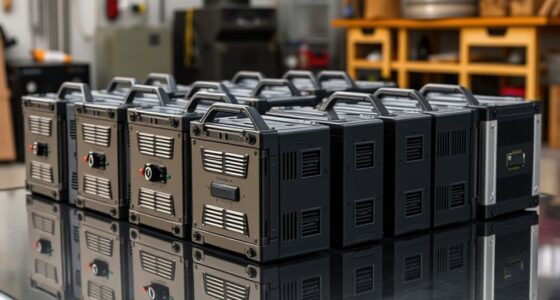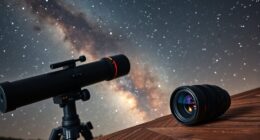If you’re looking to improve your viewing experience, I recommend exploring the 15 best Celestron focusers, including models like the Point Ball Bearing Focuser, which offer superb stability, dual-speed operation, and support heavy gear. These focusers deliver precise, vibration-free focusing essential for astrophotography and high-magnification observing. Upgrading can make a big difference in image clarity and ease of use — stay with me to discover key features that suit your needs.
Key Takeaways
- Highlights of top Celestron focusers featuring zero-backlash, dual-speed operation, and high load capacity for precise astrophotography.
- Compatibility considerations for different telescope types and tube diameters to ensure optimal performance.
- Benefits of CNC-machined aluminum construction for durability, thermal stability, and long-term reliability.
- Advanced focusing mechanisms like Point Ball Bearing Focuser for smooth, drift-free adjustments.
- Tips on selecting focusers with easy installation, fine control, and support for heavy accessories to enhance viewing experience.
Celestron Focus Motor for Schmidt Cassegrain, EdgeHD & RASA Telescopes
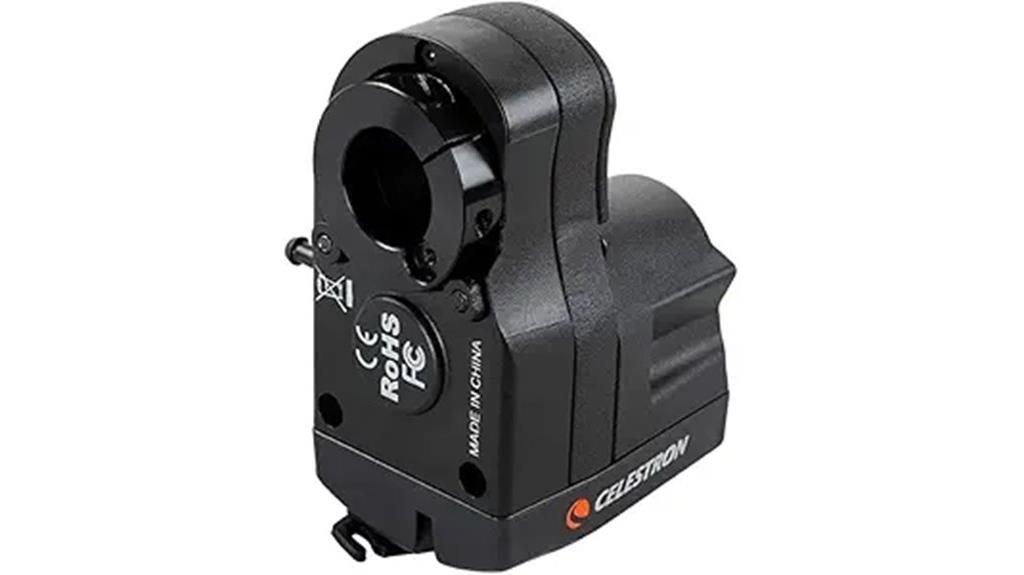
If you’re looking for a reliable way to achieve precise, remote focusing on your Schmidt Cassegrain, EdgeHD, or RASA telescope, the Celestron Focus Motor is an excellent choice. It enables electronic, hands-free focusing, helping you bring celestial objects into sharp focus effortlessly. Compatible with a wide range of Celestron telescopes, it connects easily to either your mount or computer, drawing power accordingly. With features like multiple speed rates, automatic goto, and backlash compensation, it offers automated, accurate adjustments. The included Focuser Utility software for Windows ensures simple control, making focusing smoother and more efficient during your astrophotography or observation sessions.
Best For: amateur astronomers and astrophotographers seeking precise, remote focusing capabilities for their Schmidt Cassegrain, EdgeHD, or RASA telescopes.
Pros:
- Enables hands-free, automated focusing for improved accuracy and convenience.
- Compatible with a wide range of Celestron telescopes and integrates with software for easy control.
- Features multiple speed rates, backlash compensation, and automatic goto for versatile focusing options.
Cons:
- Requires connection to a compatible mount or computer for power, which may limit portability.
- Software support is primarily for Windows, potentially limiting Mac or Linux users.
- Compatibility may vary with certain telescope models; users should verify full compatibility before purchase.
Alstar Electronic Telescope Focuser with Hand Controller
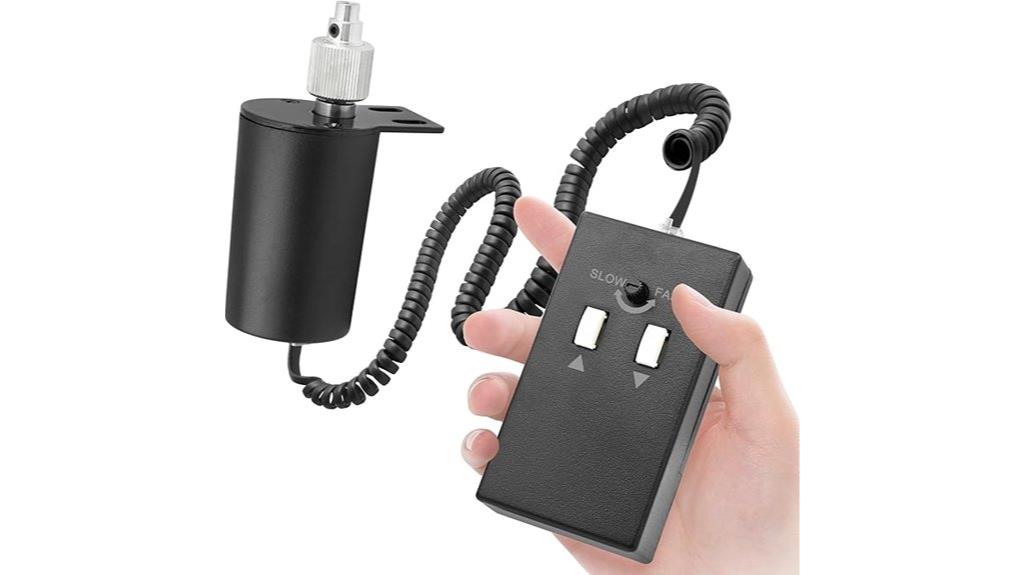
The Alstar Electronic Telescope Focuser with Hand Controller stands out for its smooth, vibration-free focusing, making it ideal for astronomers seeking precise adjustments without jitter. Its electronic AccuFocus system ensures sharp, accurate focus, while the pushbutton controller offers effortless operation. The kit includes various brackets, hardware, and coil cables, making installation straightforward with three different methods. Powered by a simple 9V battery, it features an adjustable speed control for coarse or fine tuning. Compatible with telescopes that have single-speed focusing systems, like some refractors and reflectors, it markedly enhances observational clarity and ease of use.
Best For: amateur astronomers and hobbyists seeking precise, vibration-free focusing for telescopes with single-speed focusing systems.
Pros:
- Provides smooth, vibration-free, and accurate focusing for clearer observations
- Easy to install with multiple mounting options and straightforward setup
- Operates on a standard 9V battery, offering portable and convenient power
Cons:
- Compatible only with telescopes that have single-speed focusing systems, limiting versatility
- Not suitable for Maksutov-Cassegrain, Dobsonian, or APO two-speed focusers
- May require additional adapters or brackets for some telescope models
Celestron Ultima Edge 30mm Parfocal Eyepiece
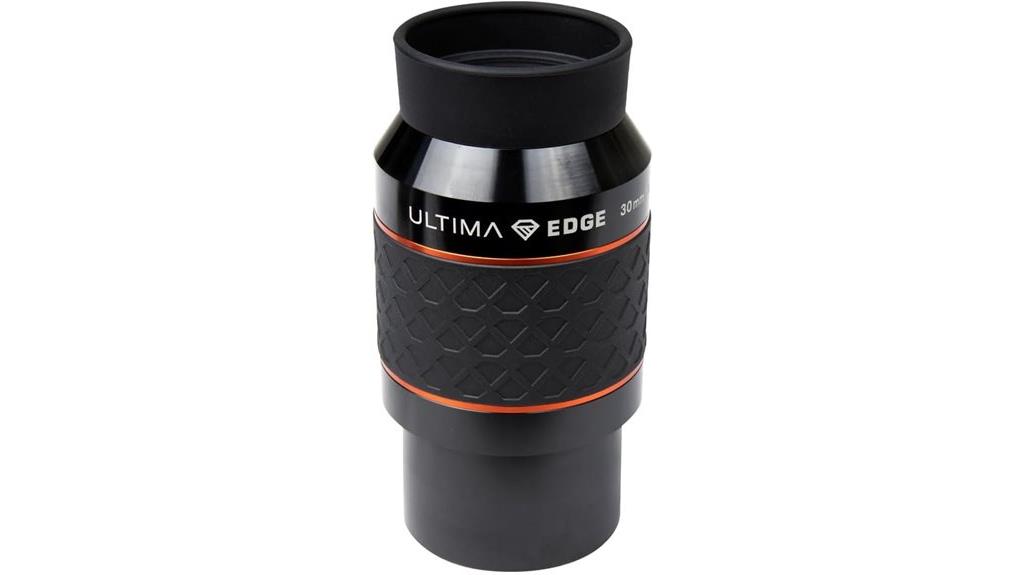
The Celestron Ultima Edge 30mm Parfocal Eyepiece stands out as an ideal choice for astronomers seeking crisp, wide-field views with minimal refocusing. Its fully multi-coated optics and 9-element lens deliver bright, sharp images across a 70° field of view, perfect for planets, the Moon, and deep-sky objects. Designed for 2” focusers, it features a flat-field design that minimizes edge distortion. The parfocal feature allows quick switching between Ultima Edge eyepieces without refocusing, boosting observing efficiency. With comfortable eye relief and durable construction, this eyepiece offers excellent value for amateur astronomers aiming for high-quality, versatile viewing.
Best For: amateur astronomers and stargazing enthusiasts seeking crisp, wide-field views with minimal refocusing, especially for planetary and deep-sky observation.
Pros:
- Wide 70° apparent field of view provides immersive viewing experiences
- Parfocal design allows quick switch between eyepieces without refocusing
- Fully multi-coated optics and 9-element lens deliver bright, sharp images with minimal edge distortion
Cons:
- May exhibit minor performance issues at fast focal ratios (f/4.5)
- Slightly heavier and larger than some 1.25-inch eyepieces, requiring more space
- Compatibility limited to 2” focusers and certain accessories, not universally compatible with all telescopes
Celestron StarPointer Finderscope
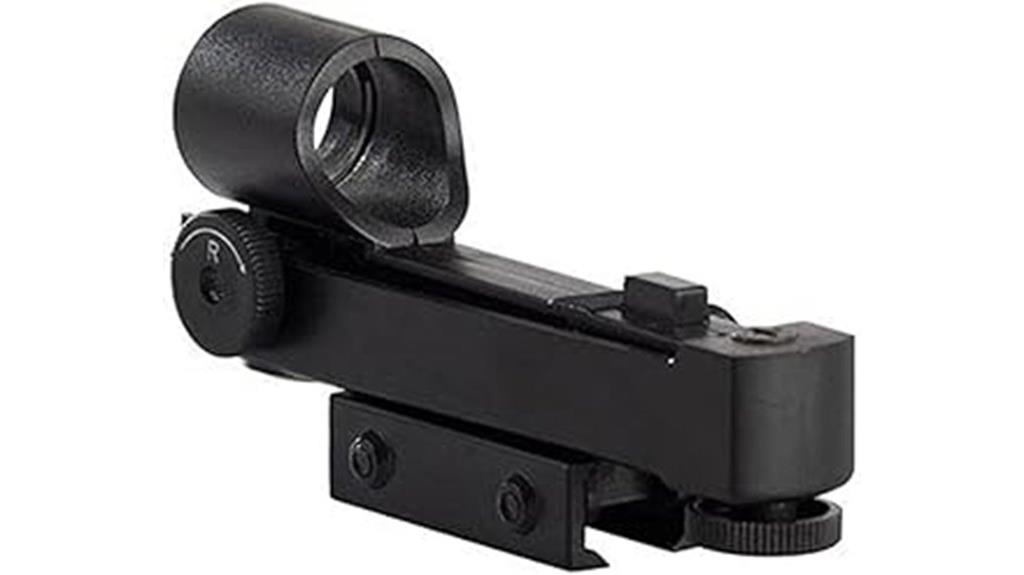
Looking for an easy-to-use finderscope that simplifies locating celestial objects? The Celestron StarPointer Finderscope is perfect, featuring “point & look” red dot technology that keeps the sky right-side up for intuitive use. It’s compatible with nearly all telescopes, thanks to its small footprint, and includes mounting bases, brackets, and a CR2032 battery for quick setup. The adjustable red dot brightness caters to night or daytime viewing, making target acquisition fast and precise. Lightweight and straightforward to calibrate, it’s ideal for both beginners and seasoned astronomers. Many users praise its ease of use, quick setup, and affordability, making stargazing more accessible and enjoyable.
Best For: beginners and experienced astronomers seeking an easy, quick, and affordable way to locate celestial objects with minimal setup.
Pros:
- Easy to install, align, and operate, reducing target acquisition time significantly.
- Brightness adjustable red dot for use in both night and daytime conditions.
- Compatible with nearly all telescopes due to its small footprint and versatile mounting options.
Cons:
- Made primarily of plastic, which may affect long-term durability for some users.
- Occasional issues with battery lifespan and inconsistent operation reported by users.
- Variability in quality control, with some units experiencing mounting play or faulty batteries.
Celestron 93973 Skyportal WiFi Module, Black
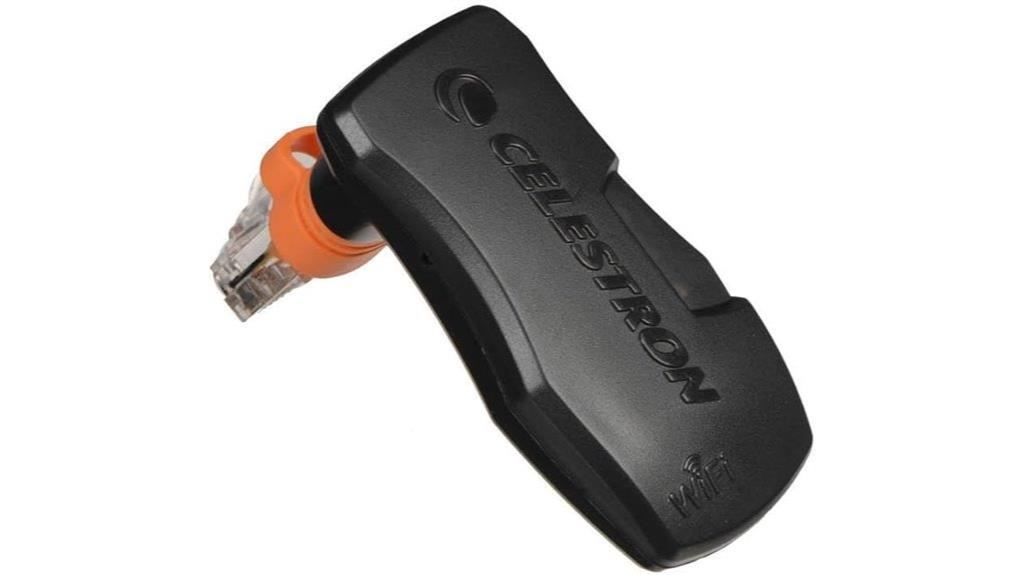
For amateur astronomers seeking effortless control over their telescopes, the Celestron 93973 Skyportal WiFi Module in black stands out as an essential accessory. It allows wireless alignment and control via smartphones or tablets using the free Sky Portal app, compatible with both iOS and Android. You can easily identify celestial objects by tapping on them in the app, then automatically slew your telescope for precise centering. With access to over 100,000 objects, multimedia content, and the Sky Tour feature for observing planning, this module makes stargazing more interactive and convenient, elevating your astronomy experience with minimal effort.
Best For: amateur astronomers who want an easy, wireless way to control their telescopes, identify celestial objects, and enhance their stargazing experience with multimedia content.
Pros:
- Wireless control via smartphones or tablets with a user-friendly app.
- Access to an extensive database of over 100,000 celestial objects, including multimedia content.
- Automated slewing and object identification for quick, precise observations.
Cons:
- Requires a compatible telescope with a motorized mount for full functionality.
- Dependent on WiFi connectivity, which may be limited in some observing locations.
- Smartphone or tablet battery life can impact the duration of remote operations.
Astromania AccuFocus Electronic Telescope Focuser
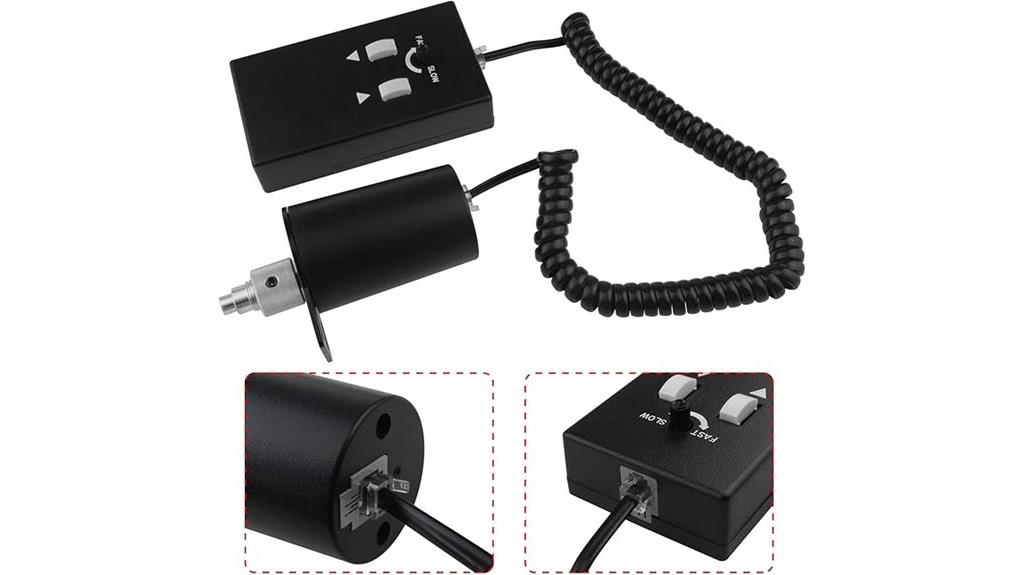
If you’re seeking precise, vibration-free focusing, the Astromania AccuFocus Electronic Telescope Focuser is an excellent choice. It offers smooth adjustments with a pushbutton controller, compatible with many Celestron, Skywatcher, Meade, and Orion telescopes, mainly for 60-127mm refractors and reflectors. The motorized DC motor allows you to switch between coarse and fine focus, making it ideal for detailed planetary or deep-sky viewing. Installation is straightforward, and it eliminates the image shake common with manual focus. With a lightweight design and a 4.6-star rating, it’s praised for affordability, ease of use, and enhancing observational precision.
Best For: amateur astronomers and stargazing enthusiasts seeking precise, vibration-free focusing for planetary and deep-sky observations with compatible refractors and reflectors between 60-127mm.
Pros:
- Provides smooth, vibration-free focusing with a pushbutton controller for precise adjustments.
- Compatible with many popular telescope brands, including Celestron, Skywatcher, Meade, and Orion.
- Easy to install and operate, enhancing observation quality without image shake.
Cons:
- Not compatible with APO two-speed focusing systems.
- Limited to telescopes within the 60-127mm range, reducing suitability for larger setups.
- Requires a 9V battery for operation, which may need frequent replacement during extended use.
Celestron Zoom Eyepiece for Telescope
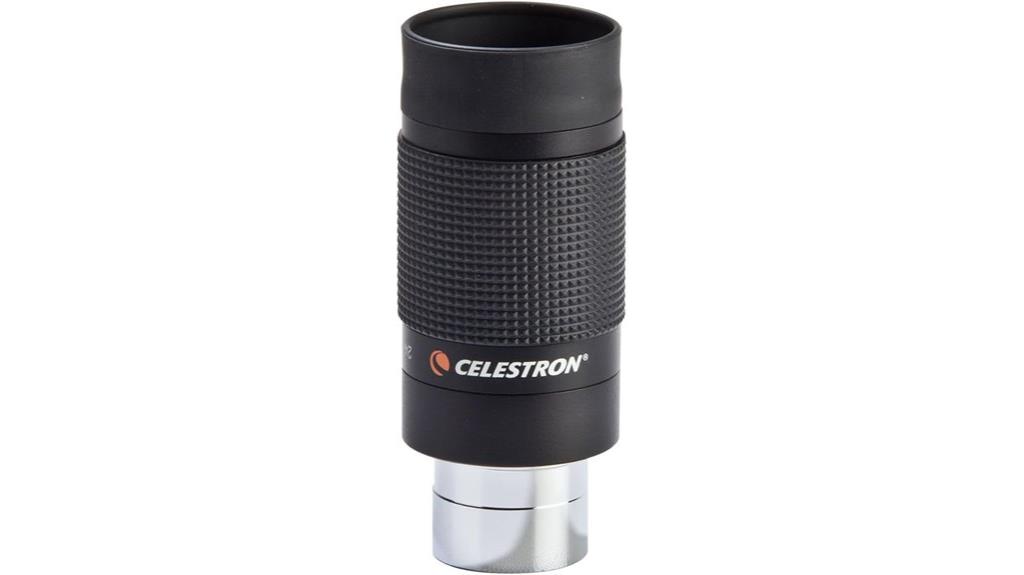
The Celestron Zoom Eyepiece for Telescope stands out as an excellent choice for amateur astronomers and outdoor observers who want versatile, high-quality magnification in a single eyepiece. It offers adjustable zoom from 8mm to 24mm, allowing smooth progression between low and high power views without changing eyepieces. Compatible with any 1.25-inch telescope or spotting scope, it includes threading for filters, adding flexibility. Its fully multi-coated optics deliver bright, sharp images with excellent contrast. This eyepiece simplifies your setup, saves money, and enhances your viewing experience, backed by Celestron’s reliable 2-year warranty and US-based support.
Best For: amateur astronomers and outdoor observers seeking a versatile, high-quality zoom eyepiece compatible with 1.25-inch telescopes for enhanced viewing flexibility.
Pros:
- Adjustable magnification from 8mm to 24mm for seamless viewing transitions
- Fully multi-coated optics for bright, sharp, and high-contrast images
- Compatible with a wide range of telescopes and spotting scopes, including filter threading
Cons:
- May be more expensive than fixed focal length eyepieces for some users
- Slightly bulkier than fixed focal length options due to its zoom mechanism
- Requires 1.25-inch telescope compatibility, limiting use with larger or specialized scopes
Celestron StarSense Explore LT114AZ Newtonian Reflector Telescope
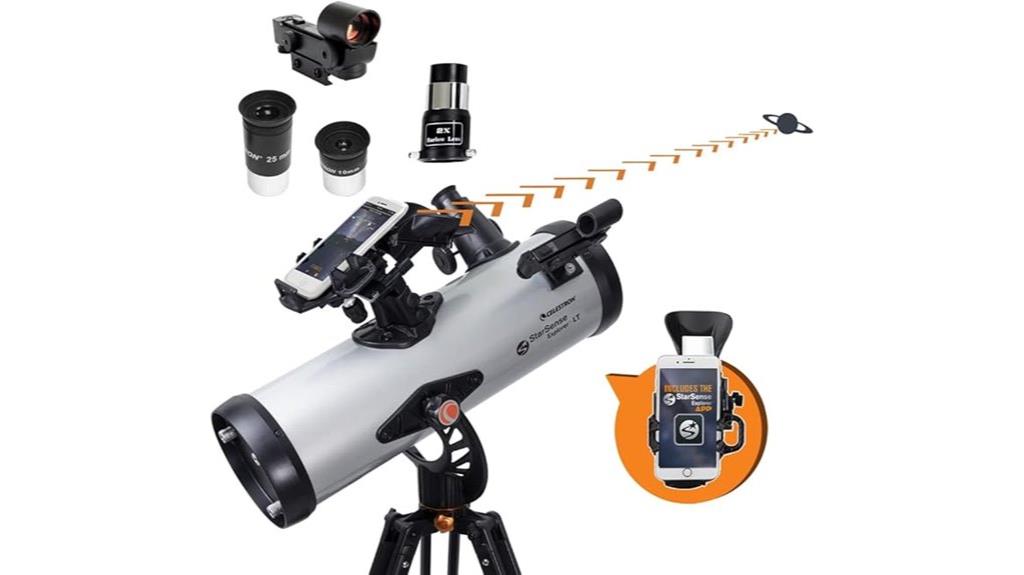
With its innovative StarSense Explorer technology, the Celestron StarSense Explore LT114AZ Newtonian Reflector Telescope stands out as an excellent choice for beginners who want effortless sky navigation. I love how it uses your smartphone to analyze star patterns and guide you to celestial objects with simple on-screen arrows. The 114mm aperture provides sharp, vivid views of the Moon, planets, and deep-sky objects like nebulae and galaxies. The manual altazimuth mount with slow motion controls makes tracking objects smooth and easy. The package includes two eyepieces, a Barlow lens, and a height-adjustable tripod, making setup versatile and user-friendly for novice astronomers.
Best For: beginners and amateur astronomers seeking an easy-to-use telescope with smart sky navigation capabilities.
Pros:
- User-friendly StarSense Explorer technology simplifies locating celestial objects.
- Includes multiple accessories such as eyepieces, a Barlow lens, and a height-adjustable tripod for versatile viewing.
- Provides clear, vivid views of the Moon, planets, and deep-sky objects with its 114mm aperture.
Cons:
- Manual altazimuth mount may require frequent adjustments for prolonged tracking.
- Smartphone docking and app reliance could be inconvenient in low-light or outdoor conditions.
- Slightly limited for advanced astronomers seeking motorized tracking or more sophisticated features.
6-Point Ball Bearing Focuser for Skywatcher and Celestron Telescopes
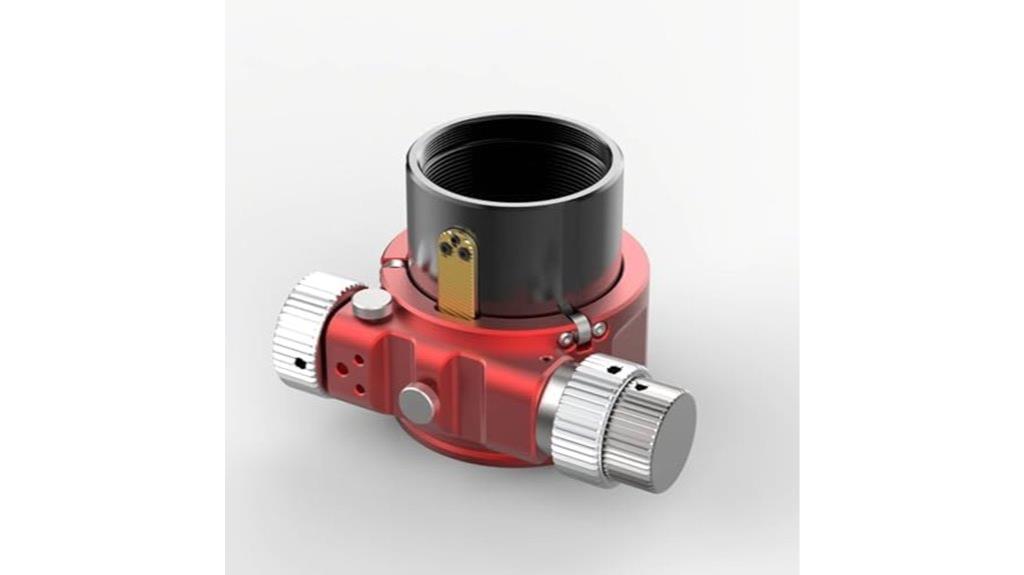
The Point Ball Bearing Focuser stands out for its zero-backlash, dual-speed design, making it ideal for astrophotographers and planetary observers who require precise, stable focusing. Its 6-point stainless steel ball-bearing mechanism ensures focus remains steady, eliminating drift and wobble. With a 10:1 gear ratio, it offers both coarse and fine adjustments, perfect for detailed imaging. Crafted from CNC-machined 6061-T6 aluminum with a thermally stable anodized coating, it supports heavy rigs up to 5kg. Compatible with many Skywatcher and Celestron models, it delivers smooth, backlash-free operation for sharp, high-definition views and astrophotography.
Best For: astrophotographers and planetary observers seeking precise, stable focusing for heavy rigs and high-definition imaging.
Pros:
- Zero-backlash, dual-speed design ensures ultra-precise focusing with minimal drift.
- Supports heavy rigs up to 5kg, making it suitable for advanced astrophotography setups.
- Crafted from durable CNC-machined aluminum with stainless steel gears for reliability and stability.
Cons:
- Compatibility requires verification based on telescope model and tube diameter before purchase.
- Slightly heavier at 3.1 pounds, which may add to overall telescope weight.
- Installation may require additional adapters for certain telescope bases or configurations.
Celestron StarSense Explorer DX 130AZ Telescope with Smartphone Dock
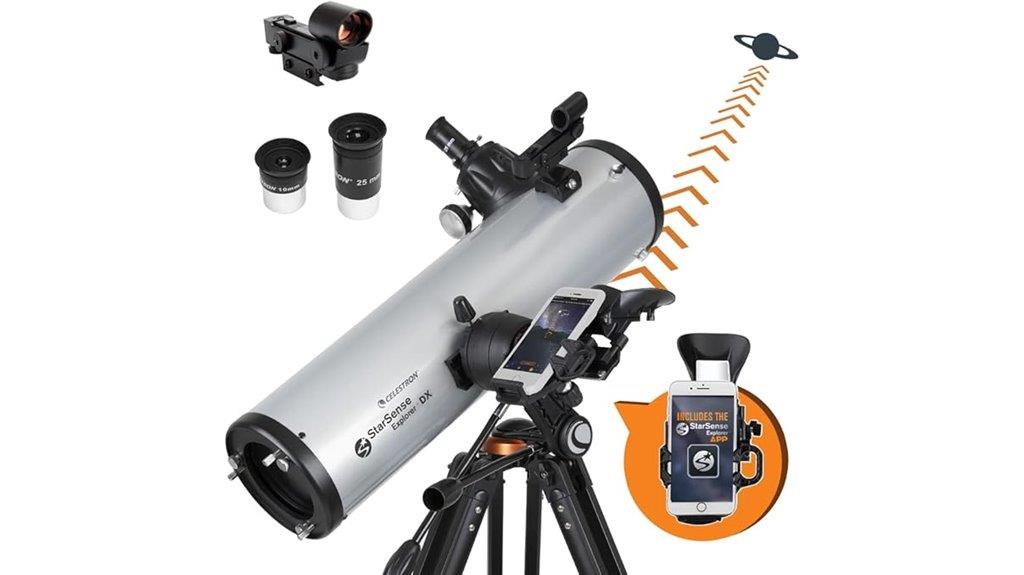
If you’re a beginner interested in exploring the night sky without prior experience, the Celestron StarSense Explorer DX 130AZ Telescope with Smartphone Dock is an excellent choice. Its 130mm Newtonian reflector provides sharp views of the Moon, planets like Jupiter and Saturn, and deep-sky objects such as the Orion Nebula and Andromeda Galaxy. The easy setup, manual altazimuth mount with dual-axis controls, and intuitive app make locating objects simple. The StarSense technology uses your phone to analyze star patterns and guide you accurately. Plus, the secure smartphone dock ensures seamless viewing. It’s a user-friendly, reliable option that makes stargazing accessible for beginners.
Best For: beginners and amateur astronomers seeking an easy-to-use, app-guided telescope for exploring the Moon, planets, and deep-sky objects.
Pros:
- User-friendly setup and intuitive app guidance make it accessible for newcomers.
- Smartphone integration with StarSense technology provides accurate sky navigation without prior experience.
- Solid optical performance with a 130mm aperture offers clear, vivid views of celestial objects.
Cons:
- Manual altazimuth mount may require more effort to track fast-moving objects compared to motorized mounts.
- Limited advanced features for experienced astronomers seeking more automation.
- Smartphone dependency means performance may vary based on device compatibility and app updates.
Celestron 93326 Omni Barlow Lens, Silver, 2 x 1.25 Inch
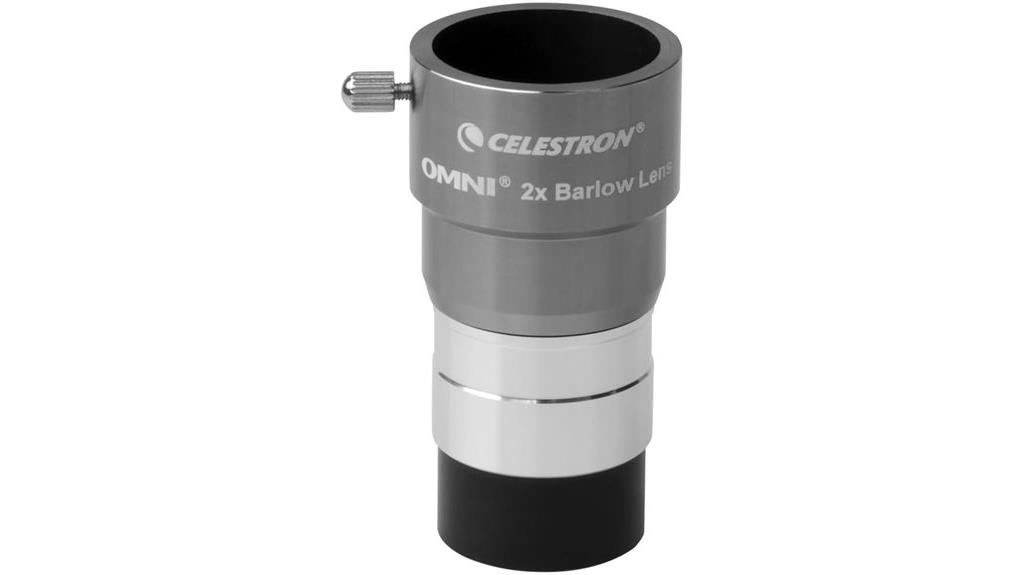
Looking to boost your telescope’s magnification without investing in a new scope? The Celestron 93326 Omni Barlow Lens is a fantastic option. It doubles the magnification of your existing 1.25-inch eyepieces, providing brighter, sharper, high-contrast views of the Moon, planets, and deep-sky objects. Its fully multi-coated optics minimize internal reflections, ensuring clear images, while the precision-machined barrel and blackened lens edges enhance durability and image quality. Compatible with standard focusers and diagonals, it’s easy to integrate into your setup. Whether you’re a beginner or experienced astronomer, this affordable, versatile Barlow lens can considerably expand your viewing possibilities.
Best For: Amateur astronomers and terrestrial observers seeking an affordable way to increase magnification and enhance image clarity with their existing 1.25-inch telescope eyepieces.
Pros:
- Doubles the magnification of standard 1.25-inch eyepieces for versatile viewing options
- Fully multi-coated optics provide bright, high-contrast, clear images
- Durable construction with precision-machined barrel and blackened lens edges for reduced reflections
Cons:
- Slightly increased light loss at higher magnifications may affect brightness in low-light conditions
- Handling and inserting the lens can be tricky for some users due to its compact size
- May introduce minor image distortions if not properly aligned or used with incompatible focusers
Celestron StarSense Explorer 8-inch Telescope with Smartphone Dock
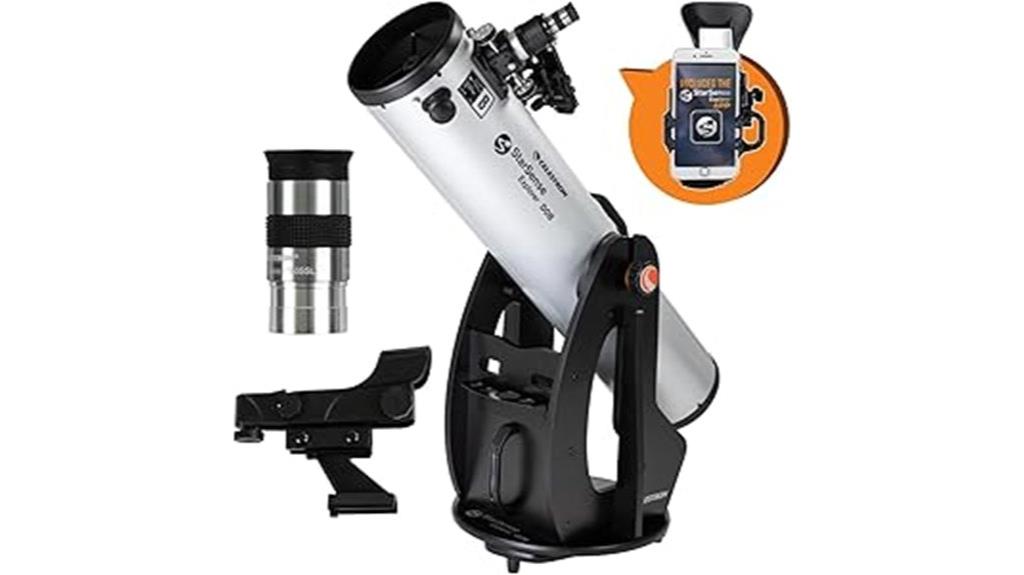
For beginners passionate to explore the night sky with minimal setup, the Celestron StarSense Explorer 8-inch Telescope with Smartphone Dock is an excellent choice. Its 8-inch Newtonian reflector provides sharp, vivid views of the Moon, planets, and deep-sky objects like the Orion Nebula and Andromeda Galaxy. The telescope’s stable Dobsonian base makes setup easy and smooth. With patented StarSense technology, it uses sky recognition to identify star patterns, guiding you to objects via a smartphone app. Compatible with iPhone and Android, the system makes star-hopping intuitive. Overall, its user-friendly design and reputable brand support make it ideal for beginners eager to start observing.
Best For: beginners and amateur astronomers seeking an easy-to-use telescope with smartphone integration for exploring the night sky.
Pros:
- User-friendly setup with app-guided star-hopping, ideal for beginners
- High-quality 8-inch Newtonian reflector provides sharp, vivid views of celestial objects
- Smartphone compatibility with Android and iPhone, enhancing navigation and tracking
Cons:
- Requires a smartphone for optimal use, which may be limiting for some users without compatible devices
- Heavier and bulkier due to the 8-inch mirror, potentially less portable for travel
- Manual altazimuth base may require occasional adjustments for precise tracking during extended viewing sessions
Celestron StarSense Autoguider for Telescopes
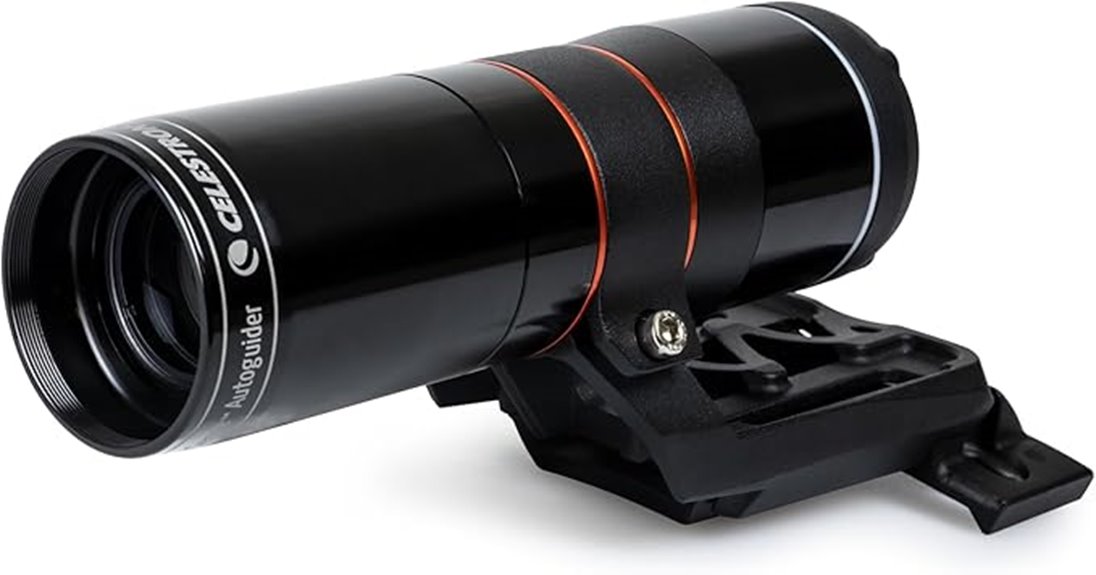
The Celestron StarSense Autoguider for Telescopes stands out as an essential tool for astronomers seeking quick, precise alignment and enhanced imaging capabilities. With its 3-minute automatic alignment using patented StarSense technology, I can set up effortlessly without manual input, improving Goto accuracy and object centering. Its high-quality optical system delivers sharper images, while the dew shield prevents dew buildup and stray light. I appreciate its flexible control options—hand control, PC software, or WiFi—making it adaptable to my preferred setup. Overall, it’s an all-in-one autoguider that simplifies astrophotography and observing, saving time and boosting precision.
Best For: amateur and experienced astronomers looking for quick, accurate telescope alignment and enhanced astrophotography capabilities.
Pros:
- Quick 3-minute automatic alignment with patented StarSense technology for easy setup
- High-quality 4-element optical system ensures sharper images and better guiding
- Multiple control options (hand control, PC software, WiFi) offer flexible operation
Cons:
- May require compatible Celestron mounts for optimal performance
- Dependence on electronic components could lead to potential technical issues
- Additional accessories might be needed for certain advanced imaging setups
Celestron 94303 Eyepiece & Filter Kit (14 Pieces)
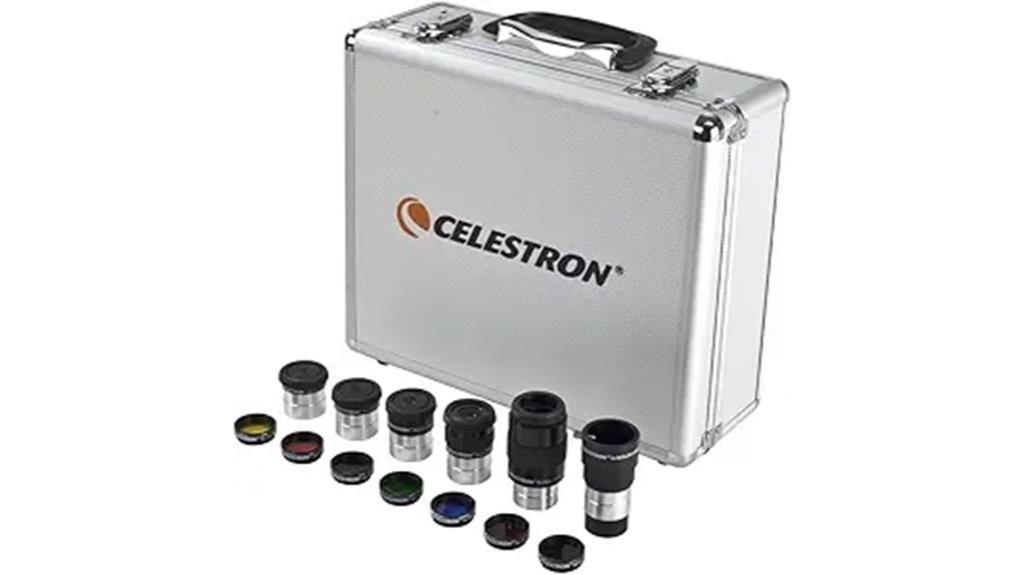
The Celestron 94303 Eyepiece & Filter Kit (14 Pieces) stands out as an ideal choice for amateur astronomers who want versatile viewing options and high-quality accessories in one package. It includes five 1.25-inch Plossl eyepieces with different focal lengths, plus a 2x Barlow lens that doubles their magnification, broadening your observational capabilities. The sharp, contrast-rich images ensure clear views of planets and deep-sky objects. Six colored filters help you target specific details, while the padded case makes it easy to transport and store everything safely. Overall, this kit enhances your astronomy experience with its combination of quality, variety, and portability.
Best For: amateur astronomers seeking a comprehensive, portable kit with versatile eyepieces, filters, and a protective case for detailed celestial observation.
Pros:
- Includes a variety of eyepieces and filters for customized viewing experiences
- High-quality Plossl design delivers sharp, contrast-rich images
- Comes with a padded, foam-lined carrying case for easy transport and storage
Cons:
- May be more suitable for beginner to intermediate users rather than advanced astronomers
- The 14-piece set could be bulky for very compact travel needs
- Limited to 1.25-inch accessories, which may restrict compatibility with larger telescope models
Celestron Signature Series Moon Telescope by Robert Reeves
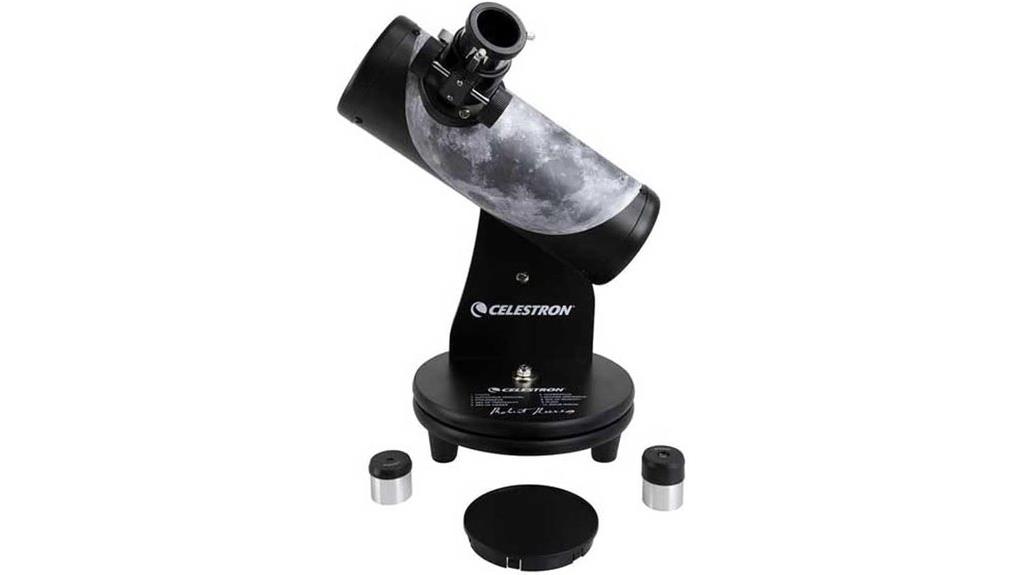
Looking for a compact, beginner-friendly telescope perfect for lunar observing and family outings? The Celestron Signature Series Moon Telescope by Robert Reeves fits the bill. Its small, lightweight design—just 4.3 pounds and measuring 9 x 9 x 18 inches—makes it super portable for trips or backyard use. The spherical glass mirror and 76mm aperture deliver bright, detailed views of the Moon’s craters and mountain ranges. With two eyepieces (15x and 75x), it’s easy to switch between wide views and close-ups. Collaborating with lunar expert Robert Reeves, this telescope also offers educational value, making it ideal for kids, beginners, and family adventures.
Best For: beginners, kids, and families seeking a portable, easy-to-use telescope for lunar and planetary observation during outdoor activities and educational exploration.
Pros:
- Lightweight and compact design (4.3 pounds, 9 x 9 x 18 inches) for easy portability and travel.
- Simple setup with basic sky navigation, ideal for beginners and casual stargazing.
- Bright, detailed lunar views with two versatile eyepieces (15x and 75x) and educational collaboration with lunar expert Robert Reeves.
Cons:
- Potential issues with collimation and image clarity for distant objects, sometimes resulting in blurry views.
- Flimsy stand may require careful handling or additional accessories for precise alignment.
- Eyepieces may lack eye relief, making viewing uncomfortable for some users, especially over extended periods.
Factors to Consider When Choosing a Celestron Telescope Focuser
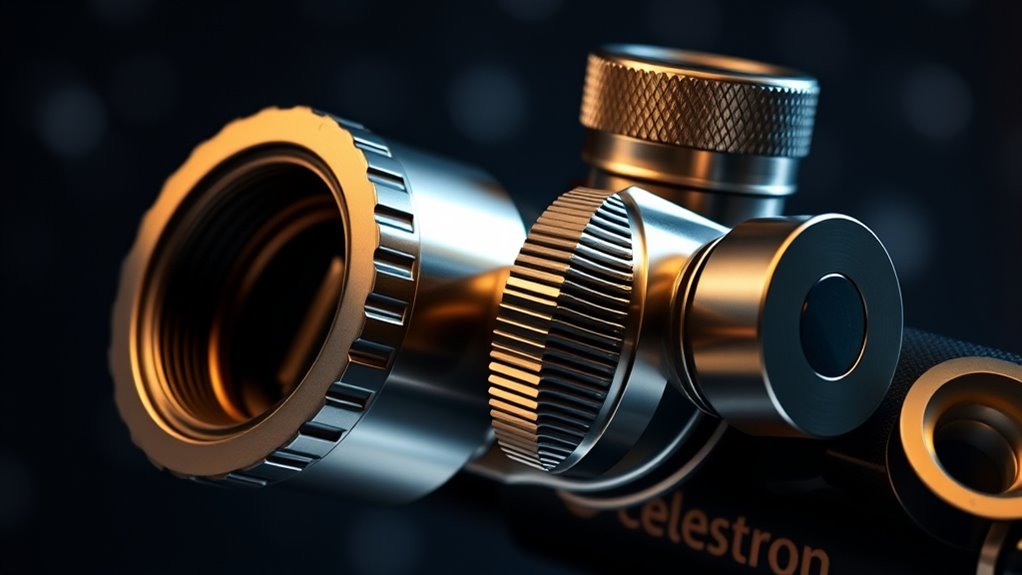
When choosing a Celestron focuser, I consider compatibility with my telescope type to guarantee proper fit. I also look at precision, stability, and load capacity to make sure it performs well under my observing conditions. Finally, ease of installation and the focusing mechanism itself are key factors that can make the upgrade smoother and more enjoyable.
Compatibility With Telescope Types
Choosing the right Celestron telescope focuser requires ensuring compatibility with your specific telescope type, whether it’s a refractor, reflector, or catadioptric. Different designs have unique mounting interfaces and optical configurations, so verifying that the focuser fits your telescope’s base or optical tube diameter is essential. You should also check if the focuser supports your telescope’s focusing system, like single-speed or dual-speed, for precise adjustments. Additionally, consider the load capacity to handle your accessories, such as cameras or filter wheels, without sacrificing stability. Compatibility with existing accessories, including adapters or extension tubes, is also vital for seamless integration. Ensuring these factors match your telescope type guarantees a proper fit and exceptional performance during your viewing sessions.
Focuser Precision and Stability
Achieving precise and stable focus is essential for high-quality astrophotography and detailed visual observing, and this depends heavily on the design and build quality of the focuser. High-precision focusers use ball bearing or gear-driven mechanisms to minimize backlash, allowing smooth, accurate adjustments. Stability comes from rigid materials like CNC-machined aluminum, which resist flexure and keep alignment intact during focusing. Micron-level repeatability, such as 0.01mm, ensures consistent focus, crucial for capturing sharp images. Dual-speed or fine-focus controls enable precise tuning, reducing vibrations that can blur views. A stable focuser should also support heavy accessories without slipping or shifting, maintaining focus during long observing sessions. These features collectively improve focus precision and stability, elevating your entire viewing experience.
Load Capacity Requirements
Selecting a Celestron telescope focuser with the right load capacity is crucial to guarantee your entire setup remains stable and functions smoothly. You need to confirm the focuser can handle the combined weight of your telescope, accessories, and cameras without strain. Check the manufacturer’s maximum weight rating, which typically ranges from 2kg (4.4lbs) to over 10kg (22lbs) for heavier models. If you’re into astrophotography, opt for a higher load capacity to support heavier cameras, filters, and mountings. Also, consider how the weight is distributed across the focuser to prevent uneven stress that could affect focusing accuracy. Finally, verify compatibility with your telescope‘s tube diameter and length to ensure the focuser can support your setup’s load without compromising performance.
Focusing Mechanism Type
The type of focusing mechanism you choose directly affects how easily and accurately you can focus your telescope. Manual focusers require you to turn a knob or thumb screw, offering straightforward operation but needing physical effort. Motorized or electronic focusers, on the other hand, enable remote or automated adjustments, often controlled via hand controllers, software, or smartphone apps for added convenience. Dual-speed focusers provide both coarse and fine adjustments, making it easier to quickly find and then precisely refine focus. The mechanism type also impacts stability, repeatability, and ease of use—especially important for astrophotography or high-magnification viewing. Your choice should balance convenience with precision, depending on your observing needs and technical comfort level.
Ease of Installation
When choosing a Celestron telescope focuser, ease of installation should be a top priority because it can save you time and frustration. Make certain the focuser is compatible with your telescope’s mounting style and diameter to guarantee a straightforward setup. Check if it comes with all necessary hardware and adapters—this simplifies the process and reduces the need for extra parts. Clear, detailed instructions or mounting templates are invaluable, helping you install correctly and efficiently. Additionally, look for models with adjustable tension or tension screws, which make calibration easier during installation. Finally, consider whether the focuser offers tool-free or minimal-tool installation, as this can considerably cut down setup time and effort.
Adjustment and Tension Control
Achieving smooth, backlash-free focusing hinges on choosing a focuser with excellent adjustment and tension control. Precise tension mechanisms keep the focuser stable, preventing drift during observations. Dual-speed focusers with fine and coarse controls let me quickly find an approximate focus, then dial in precise adjustments—crucial for high-magnification viewing. Tension screws or mechanisms help maintain focus position, reducing wobble and vibration that can blur images. For astrophotography, micron-level adjustments with repeatability of 0.01mm ensure consistent, accurate focus. A well-designed tension control system minimizes focus wobble, resulting in sharper, more stable images. Overall, good adjustment and tension control are key for a smooth, precise focusing experience, especially when fine-tuning for detailed astronomical observations.
Build Quality and Materials
Selecting a Celestron telescope focuser with solid build quality and quality materials makes a significant difference in performance. I look for focusers made from durable materials like CNC-machined aluminum and stainless steel, which guarantee longevity and stability. Using thermally stable materials, such as anodized aluminum, helps prevent focus shift caused by temperature changes, maintaining accuracy during long observing sessions. Precision manufacturing is essential; tight tolerances and smooth gear systems keep the focus aligned and reduce backlash. Ball bearing mechanisms and high-quality gear trains minimize wobble and drift, allowing for precise adjustments. A robust construction with secure tightening mechanisms is vital to prevent slippage, so I can trust my focuser to stay steady whether I’m observing visually or capturing astrophotos.
Price and Warranty
Price and warranty are crucial factors to evaluate because they directly impact the overall value and peace of mind you get from your Celestron focuser. Higher-priced models often feature advanced functions and increased durability, making them a great investment for serious astronomers. It’s essential to consider the warranty coverage, which typically ranges from 1 to 10 years, providing reassurance and protection against manufacturer defects. Some premium focusers include extended warranties or offer them as add-ons, ensuring long-term support. Keep in mind that the cost varies depending on compatibility, precision, and included features. Balancing your budget with warranty coverage helps you select a focuser that offers both quality and reliable service, ultimately enhancing your viewing experience and safeguarding your investment.
Frequently Asked Questions
How Do I Install a Celestron Focus Motor on My Telescope?
To install a Celestron focus motor, I first turn off my telescope and locate the focus knob. I then attach the motor module to the focus assembly using the provided mounting bracket, making sure it’s secure. Next, I connect the motor cable to the hand controller or mount’s motor port. Finally, I power on the system, calibrate the motor through the app or manual controls, and I’m ready to focus precisely.
What Are the Compatibility Requirements for Celestron Focusers?
Did you know that over 80% of amateur astronomers upgrade their focusers within the first year? Compatibility-wise, I always check my telescope’s model and mount type before choosing a Celestron focuser. It’s essential that the focus motor matches the telescope’s size and thread specifications. I recommend reviewing the product details carefully, ensuring it supports your specific Celestron model to avoid any installation issues.
How Can I Troubleshoot Focus Slipping or Jitter Issues?
If you’re experiencing focus slipping or jitter, I recommend checking the tension on your focuser knob and tightening it if needed. Make sure your eyepiece or camera is securely seated, as loose connections cause instability. Also, inspect for any debris or dirt on the focuser track. Sometimes, lubricating the focuser with a small amount of suitable oil can help smooth movement. Regular maintenance keeps your focusing sharp and steady.
What Accessories Enhance the Performance of Celestron Focusers?
You’ll be amazed how much accessories can boost your Celestron focuser! I swear, a good quality right-angle finder or a motorized focuser upgrade transforms your viewing like magic. Adding a focus lock keeps everything steady, preventing slipping. A dew shield or heater also guarantees clear views without interruptions. These small upgrades make a huge difference, turning your telescope into a powerhouse for sharp, crisp images every time you look through it.
Are Electronic Focusers Suitable for Beginner Astronomers?
Yes, electronic focusers are suitable for beginner astronomers. They make focusing easier and more precise, which is especially helpful when trying to capture clear images or observe planets in detail. I’ve found that they reduce frustration and save time, allowing me to enjoy my stargazing experience more. If you’re new to astronomy, I recommend trying an electronic focuser—it’s a great upgrade that enhances your overall viewing.
Conclusion
Choosing the right Celestron focuser can transform your stargazing experience, making your views sharper, your setup smoother, and your sessions more enjoyable. Whether you prioritize precision, ease of use, or compatibility, the right focuser will elevate your astronomy adventures. So, consider your needs, weigh your options, and invest in a focuser that enhances every observation. Because when your equipment works seamlessly, your passion for exploring the cosmos shines even brighter.
